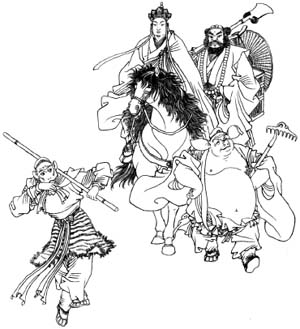Note: In this post I will use both the Wade-Giles and Pinyin systems of transliteration. Yeah, I’m a rebel.
Also also note: I guess I am supposed to say this book review contains spoilers. Of course it does. It’s a book review. The book came out in 1592, so you may have had a chance to read it.
Xiyouji, or The Journey to the West, ranks with The Romance of the Three Kingdoms, The Story of the Stone and Outlaws of the Marsh as one of the four great classics of Ming Dynasty literature most gweilo will never read.
But its relative obscurity among ghost-faced big-nosed foreign devils is no reason not to enjoy it. It is a fantastic story, in every sense of the word. It tells the tale of a Buddhist monk and his four supernatural disciples (a monkey, a pig-man, a disgraced general from heaven and a dragon made into a horse) as they travel from China to India. In the course of 100 chapters, the disciples fight demons, anger gods, steal from immortals, escape from wild traps, and often cause more trouble by trying to solve a problem than they would have by leaving it alone.
Xiyouji can be read by those who know nothing about Chinese religion or folklore as an epic adventure, full of humor, monkey violence and poetry. For those who study Asian culture, the story provides an even richer experience, as the subtext offers a fascinating look at the perplexing religious multiplicity of Chinese society. And poop jokes.
Some readers will only see absurdity in Xiyouji; others will focus on religious or social satire. As with Gulliver’s Travels or The Odyssey (its closest Western equivalents), no single focus of interpretation can suffice. The true nature of Xiyouji is the harmonic of lyricism, religious musing, manic bloody adventure, childish humor, wanderlust and satire.
I think this combination is the reason the story has been immensely popular in Asia for centuries. It’s been made into TV shows, opera, video games, manga, cartoons (including Dragonball Z) and several movies. I got a Monkey King doll in Hong Kong that lights up, spins around on a green cloud and plays “It’s a Small World” for no apparent reason. Coolest toy ever.
 I’m told an early concept for the fourth Indiana Jones film centered on Xiyouji, but rather than go with that marvelous idea, Spielberg created “Indiana Jones and the 123 Minutes You’ll Never Get Back.”
I’m told an early concept for the fourth Indiana Jones film centered on Xiyouji, but rather than go with that marvelous idea, Spielberg created “Indiana Jones and the 123 Minutes You’ll Never Get Back.”
About the Guy Who is Probably the Author:
As with many classical Chinese works, the precise authorship of Xiyouji is impossible to verify, but it is generally attributed to the poet Wu Cheng-en of the late Ming Dynasty (that’s the 16th Century to you and me, Rusty). Wu Cheng-en, a scholarly son of a merchant, failed the civil service exam several times and spent two years in prison on a charge of corruption that was later found to be bogus. All of which may have led to Wu Cheng-en being a wee bit cynical. And who better to write a satire than a bitter and literate ex-con?
Some Buddhist History Stuff You Can Skip if All You Want to Know About is Monkeys:
Long, long ago, in a subcontinent far, far away Shakyamuni (aka Siddartha Gautama, AKA the Buddha, AKA that guy you see statues of in various home décor stores) attained enlightenment and spent the next several decades figuring out different ways to explain what he understood to people of varied capacities.
After his death by dysentery (which makes me glad that, unlike Christians, Buddhists don’t use a representation of their founder’s death as a symbol) the Buddha’s teachings were passed on as oral tradition for a few centuries before being written down in Sanskrit or Pali. Along the way, several schisms and schools developed, the major divisions being the Hinayana (lesser vehicle) and Mahayana (greater vehicle). As you can probably guess, the Mahayanists came up with those names.
When Buddhism spread outside of India, the Mahayana schools traveled first and the Hinayana followed much later. Because of that, the introduction of Buddhist sutras into China came in multiple versions and in no particular order. Debate raged for centuries as to which teachings were complete and what the order of the teachings really was.
 Several prominent Chinese monks made pilgrimages to India, hoping to answer the age-old question, “Which came first, the Buddha or the Dharma?” The most famous of these pilgrims was Xuanzang (602-664) who traveled through India and central Asia for seventeen years, translating some 75 sutras and recording his experience in the Record of the Western Regions of the Great Tang Dynasty. The account is scholarly—similar to an anthropological study—and cannot be considered an intentional work of fantasy. Over the centuries, however, the true story of Xuanzang’s journey became aggrandized and mixed with folktales, resulting in the strange and magical Xiyouji.
Several prominent Chinese monks made pilgrimages to India, hoping to answer the age-old question, “Which came first, the Buddha or the Dharma?” The most famous of these pilgrims was Xuanzang (602-664) who traveled through India and central Asia for seventeen years, translating some 75 sutras and recording his experience in the Record of the Western Regions of the Great Tang Dynasty. The account is scholarly—similar to an anthropological study—and cannot be considered an intentional work of fantasy. Over the centuries, however, the true story of Xuanzang’s journey became aggrandized and mixed with folktales, resulting in the strange and magical Xiyouji.
(Part one of three.)










